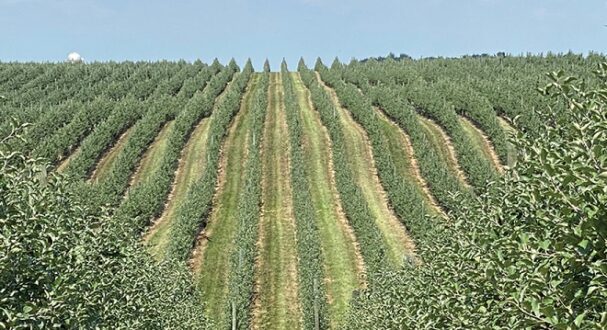

Oct 25, 2023Michigan Fruit Ridge growers share strategies
Apple production techniques were shared at three orchards in the Fruit Ridge area near Conklin, Michigan, during the Michigan Pomesters’ 12th annual Ridgefest.
Roger Umlor, co-owner of Umlor Orchards/Centennial Fruit, displayed a block of 15-year-old, side grafted Pink Lady Maslin during the early August event.


“We are grafting them over because when they are thin-skinned we have trouble getting them over the grader. We’re cutting our losses by grafting them over to Gale Galas, one of our favorite Galas to grow on the farm. The colors are good and it sizes well,” Ulmer said. “It makes for a quick conversion. You are still growing apples on the top. The space is filled and we’re in full production.”
Umlor said they trimmed the trees “hard” this winter, to get more sunlight. “We came in six weeks ago and trimmed them again. They did take off growing again,” he said.
Robbi Van Timmeren, who has been grafting trees for nearly 40 years, helped Umlor.
“The advantage of this graft is you can go as low as you want to. You can do bi-ax with this. You can put it on a vigorous variety, like a Gala or Fuji. You get production back really quick,” Van Timmeren said.
“Typically, it’s one-third, one-third and one-third. The first year you’re going to take the top of the tree off, and put a side graft that works from bottom up so we can get under the trees,” she said. “And then in July, you come back in and take a little more off. Then in the third year take a little more off. We don’t want this graft blowing out, leading to issues with winter injury or even black stem bore.”
Carl Dietrich, grower, has blocks of EverCrisp and Ambrosia at Ridgeview Orchards. “It was a big struggle in the nursery getting tree training (on the EverCrisp),” Dietrich said. “We bench-grafted them all in March. And then, we started growing buds for two years, and planted in 2021. They are growing real well.”
Depending on the vigor and crop load, Dietrich may try to control blind wood by click-pruning around mid-June “in terms of cutting wood in half, and then getting buds to form. It is perfect timing for that.”
Ridgeview’s Ambrosia plantings are on G-41, which he said was too big of a rootstock. “It wouldn’t have been like this if it was 327s, which is what I wish we would have used,” Dietrich said. “We had a hard time getting the trees to calm down. They finally cropped really nicely last year. We somewhat over-thinned this year. Our biggest struggle was just to get them to spur up.”
Ambrosia has a lot of vertically-grown limbs, and color is a very big struggle. “After we finally got it to the top wire, and we finally started cropping, we’re going to be able to actually come through and do the correct kind of summer and winter pruning, and hopefully get better color,” Dietrich said.


Brent Klein, operator of B&L Orchards, shared challenges he’s faced with phytophthora aerial blight in his nursery production, including plantings of several apple varieties.
“The nursery we planted in spring 2023 was on bench-grafted Bud 10,” Klein said. “We Lost 30% of them completely. Another 30%-40% we were able to chip bud.”
In the 2015 and 2016 plantings, B&L started seeing a lot of leaves with a lime-green tint to them, along with a lot of bronzing. Last summer, the 2018 planting started to show phytophthora aerial blight, he said.
“We started digging deeper and found we have some severe compaction issues,” Klein said. “There’s a pretty good hard pan from four to six inches down. We dug a hole and took soil samples and they showed the pH is considerably low. Even if the nutrients are getting there, the tree can’t pull it up.”
Using a two-row ripper built by Phil Brown Welding, B&L Orchards tried to open up the soil to get the high sodium content to wash down in the drain tile to try to get the pH up.
“We put two tons of lime on and several hundred pounds of potash and gypsum trying to break the soil loose. We did a couple of other things through the drip to loosen the soil up as much as I can based on what the budget allows.
“In the 2018 planting, we made pretty good strides,” he said. “It’s definitely not a two- or three-year fix. I think it’s more like five or 10.”
— Gary Pullano, senior FGN correspondent














